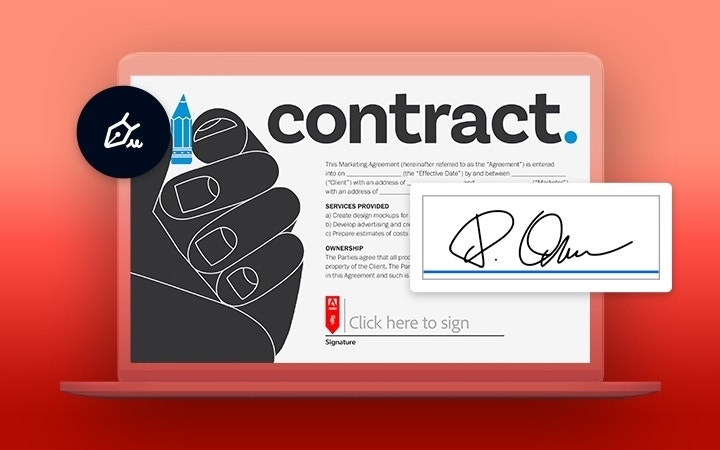ADOBE ACROBAT
Online contract signing for business.
Secure your business with trusted contracts.

Formalize business agreements with a contract
A contract is a legal agreement between people who are looking to conduct business together. These documents lay out all the details of a project or deal. Then both parties agree to the terms of the written contract by signing on the dotted line.
Why do you need a contract?
If parties don’t have a written copy of an agreement, it can be difficult to determine if it gets broken. While some regions enforce verbal agreements, it’s better to get everything in writing.
Contracts help both parties align and understand what’s expected of them in their relationship. But with printing, signing, mailing, faxing, copying, and filing, paper contracts can be time-consuming and a source of frustration. Luckily, with digital e-signature solutions, you can quickly create, share, sign, and save contracts digitally.

How to get a contract signed electronically.
If you have a complete contract document that’s ready for signatures, follow these steps.
Sign a contract yourself.
Electronically signing a contract is no problem with Acrobat Sign. Simply open a PDF form or contract in Acrobat and use the Fill & Sign tool.
1 Open a PDF document in Acrobat.
2 Select the Fill & Sign tool in the right pane. Click a text field and type or add a text box. Add checkmarks where needed.
3 Select Sign in the top toolbar. Draw, type, or choose an image for your signature.
4 Click Next to share your signed copy of the agreement with others.
Request signatures from others.
Sign makes it simple to gather the signatures that you need. All you need to do is select Tools › Request E-signatures and Sign will prompt you for the email addresses of the people you want to sign your contract.
You can even password-protect the contract to ensure that only the involved parties can open it. Set a completion deadline with automated reminders that will prompt recipients to take action if the contract sits in their inbox for too long. And add branding to signature requests for a more personalized customer experience.
Create contract templates with Acrobat.
Once you create one PDF contract, you can upload it to Acrobat and save it as a template to streamline your workflow. Convert multiple document types into PDFs, such as Google Docs or Word Docs. So no matter how you create your digital contract, you can easily turn it into a template or get it e-signed.
1 Open Acrobat for the web. Go to the home page and select E-sign › Create e-sign template. Then upload your contract and enter a name for the template you’re making.
2 Upload your file. Select Create as Reusable Document, Create as a Reusable Form Field Layer, or both.
3 Choose your permissions.
4 Click the Preview or Add Fields button.
5 Drag and drop your form fields.
6 Click the Save button.
Tip: Always consult the experts.
Find a law firm that specializes in your industry so you can get legal advice as you write your contract.

6 elements of a viable contract.
Individual contracts vary in length, complexity, and particular terms. However, there are six essential elements of a contract that you should always consider as you create or review one:
1. Offer
Every contract starts with an initial statement of what each party wants and what they have to give. This is known as an offer.
2. Acceptance
In some contracts, once an offer is presented, a party can decide to accept or reject it. Acceptance can be conditional or contingent on other factors.
3. Awareness
All parties to a contract know about the agreement that they’re entering into. Ideally everyone involved is participating in the agreement freely and without being strongly convinced.
4. Consideration
Contracts have to include the value of what’s agreed upon, like a product, property, or service. There doesn’t need to be a monetary amount attached to what’s being discussed, but all parties must acknowledge that the thing or service has an agreed-upon value.
5. Capacity
Everyone signing contracts needs to understand the terms of the agreement and be of sound mind (they comprehend what is going on around them). Parties who are forced to sign a contract against their will, or who are not able to understand what the contract means, do not have the capacity to be a signatory.
6. Legality
Contracts must comply with the federal, state, and local laws and regulations in the area where you reside and do business.
Nail down all the details.
The components of contracts vary depending on the industry. But in general, any detail that’s important to the project or deal needs to be outlined in the contract. Anything left up for interpretation can cause confusion later. For this reason, precise explanations in every clause are key.
- Identity and contact information. Name both parties and how to get in contact with them.
- Purpose of the contract. List the purpose of the contract and any underlying assumptions.
- Signers’ obligations and rights. Name the duties and the rights that each party will have in the arrangement.
- Timeline details. What is the duration of the contract? List important dates or milestones.
- Payment terms. Describe how payments will be handled, including dates and dollar amounts.
- Warranties and disclaimers. List what one party is or isn’t guaranteeing to the other party.
- Liabilities and indemnification. Identify who’s responsible for damages and who’s protected from liability.
- Signatures for both parties. Both signatories must sign to show their agreement.

Are e-signatures considered legitimate?
Contracts are a crucial part of business, so it may feel risky to move the process online. However — while laws vary by region — in most industries and countries, electronic signatures are seen as legal, enforceable, and trusted.
When you move your contract management process online, you’ll save time and money and avoid hassle for yourself and the person signing. You and your clients can sign contracts on the go, from any device, and easily organize your documents in the cloud.
Try Acrobat Sign today to see how quick and easy it can be to get contracts signed digitally.
